Physical Address
304 North Cardinal St.
Dorchester Center, MA 02124

RFID Antennas are necessary elements in an RFID system because they convert the RFID reader’s signal into RF waves that can be picked up by RFID tags. Without some type of RFID antenna, whether integrated or standalone, the RFID reader cannot properly send and receive signals to RFID tags.
Unlike RFID readers, RFID antennas are dumb devices that receive their power directly from the reader. When the reader’s energy is transmitted to the antenna, the antenna generates an RF field and, subsequently, an RF signal is transmitted to the tags in the vicinity. The antenna’s efficiency in generating waves in a specific direction is known as the antenna’s gain. To put it simply, the higher the gain, the more powerful, and further-reaching RF field an antenna will have.
The RFID antenna gives off RFID waves along a horizontal or vertical plane, which is described as the antenna’s polarity. If the RF field is a horizontal plane, is it described as horizontally linear, and the same principle applies to an RFID antenna that creates a vertical plane.
An antenna’s polarity can have a significant impact upon a system’s read range. The key to maximizing read range is to ensure an antenna’s polarity aligns with the polarity of the RFID tag. If these do not match up, for instance, a vertical linearly-polarized antenna and a tag with a horizontal linearly-polarized antenna, the read range will be severely reduced.
A circularly-polarized antenna transmits waves that continually rotate between horizontal and vertical planes in order to give an application enhanced flexibility by allowing for RFID tags to be read in multiple orientations. However, because the energy is divided between two planes, a circularly-polarized antenna’s read range is shorter versus a similar gain linear antenna.
RFID Antennas, like most RFID equipment, can be divided into different categories that help to narrow down the best antenna for an application. Even though antennas are grouped by a few different factors, the most common groupings for RFID Antennas are polarity (circular vs linear) and ruggedness (indoor vs. outdoor).
Frequency Range– 902 – 928 MHz, 865 – 868 MHz, 860 – 960 MHz
Polarity– Circular, Linear
Ruggedness– Indoor IP Rated, Outdoor IP Rated
Read Range– Proximity (Near-Field), Far-Field
Mounting Type– Shelf Antenna, Ground Antenna, Panel Antenna, Portal Antenna
Most RFID antennas are typically priced between $50 and $300 per antenna, but there are a few that cost more because of key, application-specific factors, such as ground/mat antennas. These antennas are specialized for applications such as race timing and must be rugged enough to survive and perform well while people, bikes, or even go-carts run over them. Specialized antennas can increase a system’s cost significantly but are also an investment that can be the difference between a functioning and non-functioning system.
How much read range do you need?
Is it possible to always know or control the orientation of the RFID tag relative to the antenna’s position in your application?
Any excessive environmental conditions to consider? Excessive heat, cold, moisture, impact, etc.?
Will the antenna be mounted indoors or outdoors?
Size limitations (i.e. the antenna can be no larger than x by y by z inches)?